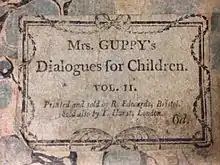Sarah Guppy
Sarah Guppy, née Beach (5 November 1770 – 24 August 1852) was an English engineer and the first woman to patent a bridge, in 1811. She was also an inventor and designer who developed a range of products.[1]
Sarah Guppy | |
|---|---|
 Stencil by Stewy from a portrait by Isambard Kingdom Brunel | |
| Born | Sarah Maria Beach 5. November 1770 Birmingham, England |
| Died | 24 August 1852 (aged 81/82) Clifton, Bristol, England |
| Nationality | English |
| Spouse(s) |
|
| Children | Samuel Guppy, Jr. (1795–1875), Thomas Richard (1797–1882), Sarah Maria Ann (1801– ), Mary Elizabeth (1806–1841), Robert (1808– ), Grace (1809–1838). |
| Engineering career | |
| Discipline | Inventor |
| Significant design | A tea or coffee urn that also cooked eggs, the fire hood, a candlestick that made candles burn longer |
| Significant advance | Improvements in ship caulking and barnacle prevention |

Following the publication of an erroneous entry in the ONDB in 2016, now corrected[2] Guppy has in recent times been incorrectly credited with the design of Isambard Kingdom Brunel's Clifton Suspension Bridge. She designed and patented her own chain bridge in 1811 (before the announcement of the first competition for a bridge across the Avon Gorge) but this design was never realised. [3] Brunel’s winning design for a bridge across the Avon Gorge differed from Guppy's patent in several significant ways: it had a deck suspended from flat wrought iron bar links rather than resting on top of chains like Guppy's; and it did not feature riverbed foundations (a key component of Guppy's design) as it was constructed 75 metres above high tide where the piers were not at risk of damage from water erosion. [4]
Early history and inventions
Sarah Maria Beach was born in Birmingham, England, and baptised in November 1770 as a daughter of Richard and Mary Beach.[5] She married Samuel Guppy in 1795. In 1811 she patented the first of her inventions, a method of making safe piling for bridges. Thomas Telford asked her for permission to use her patented design for suspension bridge foundations, and she granted it to him free of charge.[6] As a friend of Isambard Kingdom Brunel and his family she became involved in the Great Western Railway, writing to the directors with ideas and giving her support. In 1841 she wrote a letter recommending planting willows and poplars to stabilise embankments. She continued to offer technical advice despite the fact that, as she wrote, "it is unpleasant to speak of oneself—it may seem boastful particularly in a woman."[7]
Patents and publications

The family took out 10 patents in the first half of the nineteenth century, including a method of keeping ships free of barnacles that led to a government contract worth £40,000. Other inventions included a bed with built-in exercise equipment, a device for a tea or coffee urn which would cook eggs in the steam as well as having a small dish to keep toast warm, and a device for "improvements in caulking ships, boats and other vessels." In later life she wrote The Cottagers and Labourers Friend and Dialogues for Children, invented the fire hood or Cook's Comforter, and patented a new type of candlestick that enabled candles to burn longer.[8][9]
Marriage and family
After marrying Bristol merchant Samuel Guppy they lived in Queen Square and Prince Street,[10] a leading light of the Bristol and Clifton social scene. The couple had six children, including Thomas Richard, who with older brother Samuel operated the Friars Sugar Refinery in Bristol (1826–42) before becoming an engineer and associate of Brunel, contributing significantly to the design of SS Great Western and SS Great Britain. Brunel painted a portrait of the younger Sarah Guppy c. 1836.[11]
Later life
In 1837 the widowed Sarah, now 67, married Richard Eyre Coote, 28 years her junior. For a while they lived at Arnos Court, Brislington, but Richard ran through his rich wife's money at a rapid rate, spending on horses and neglecting her. Sarah moved into 7 Richmond Hill, Clifton, in 1842. She bought the land opposite the house for the benefit of Clifton residents and it still remains green space.[12]
Notes and references
- Dresser, Madge (April 2016). "Guppy, Sarah (bap. 1770, d. 1852". Oxford Dictionary of National Biography (online ed.). Oxford University Press. doi:10.1093/ref:odnb/109112. Retrieved 31 May 2016. (Subscription or UK public library membership required.)
- "Oxford Dictionary of National Biography". www.oxforddnb.com. Retrieved 3 April 2019.
- Cork, Tristan (27 May 2016). "Recognition at last for the mum-of-six who designed Bristol's Clifton Suspension Bridge - not Brunel". Bristol Post. Archived from the original on 28 May 2016. Retrieved 30 May 2016.
- "Did Sarah Guppy Design the Clifton Suspension Bridge?". Clifton Suspension Bridge Trust. Retrieved 25 June 2018.
- Birmingham, England, Church of England Baptisms, Marriages and Burials, 1538–1812, Sarah Beach, In: Ancestry.com
- Rendell, Mike. "Sarah Guppy, Eclectic English Inventor". Amazing women in History. Retrieved 13 October 2015.
- PRO RAIL 1014/8/7
- One Hundred Key Facts on the Bristol City – region and Science
- Plaque #932 – Open Plaques
- Bristol Record Office BCC/F/E/3285, BCC/F/E/3140
- Brunel: 'In Love with the Impossible' ISBN 978-0955074202
- BBC – Bristol – Entertainment – Shows of strength